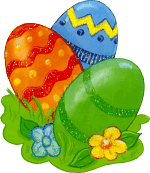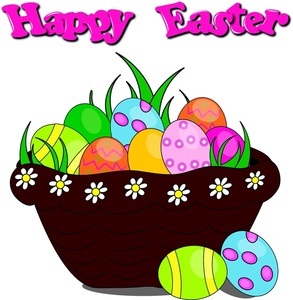
Next to the Easter bunny, the most familiar symbol is the Easter egg. Like others, the egg has a long pre-Christian history. Again there's no certainty as to why it became associated with Easter.
Many Ancient cultures viewed eggs as a symbol of life. Hindus, Egyptians, Persians, and Phoenicians believed the world begun with an enormous egg. The Persians, Greeks, and Chinese gave gifts of eggs during spring festivals in celebration of new life all around them. Other sources say people ate dyed eggs at spring festivals in Egypt, Persia, Greece, and Rome. In ancient Druid lore, the eggs of serpents were sacred and stood for life.
Early Christians looked at the connection eggs had to life and decided eggs could be a part of their celebration of Christ's resurrection. In addition, in some areas, eggs were forbidden during Lent; therefore, they were a delicacy at Easter. Since many of the earlier customs were Eastern in origin, some speculate that early missionaries or knights of the Crusade may have been responsible for bringing the tradition to the West.
In the fourth century, people presented eggs in church to be blessed and sprinkled with holy water. By the twelfth century, the Benedictio Ovorum had been introduced authorizing the special use of eggs on the holy days of Easter. The timing of this blessing would uphold the idea that Crusaders may have brought the tradition back. Even though eggs had been used previously, the Crusaders may have made the custom more popular and widespread.
In 1290, Edward I of England recorded a purchase of 450 eggs to be colored or covered with gold leaf. He then gave the eggs to members of the royal household.
Once the custom became accepted, new traditions began to grow up around it. Eggs were dyed red for joy, and in memory of Christ's blood. Egg rolling contests came to America from England, possibly as a reminder of the stone being rolled away.
What about the familiar Easter Egg hunt? One source suggested that it grew out of the tradition of German children searching for hidden pretzels during the Easter season. Since children were hiding nests for the Easter Bunny to fill with eggs at the same time they were hunting pretzels, it was only a small leap to begin hiding eggs instead.
As Christianity spread, more familiar traditions, symbols and
celebrations of spring were associated with Easter - Christ coming back
to life after death. One of the oldest spring symbols in the world is
the egg. The oval shape of the egg was the same shape for a raindrop
and a seed. These two were important life-giving elements. The egg
itself promises new life as in spring, birds, and many other animals are
hatched from eggs. In fact, the Persians, Hindus and Egyptians believed
that the world began with a single egg. In ancient China, Rome and
Greece, eggs were given as springtime gifts. In Polland and Russia,
hours are spent on drawing intricate designs on Easter eggs. In England,
members of the royal families gave each other gold-covered eggs as
Easter gifts in the middle ages. The most famous Easter egg decorator
was
Peter Carl Faberge. He designed eggs from gold, silver and other precious
gems for kings of Europe and czars of Russia. These eggs are priceless
now and can only be found in museums and private collections. In early
America, children decorated their eggs by using dyes made from natural
materials like fruit and leave coloring.

